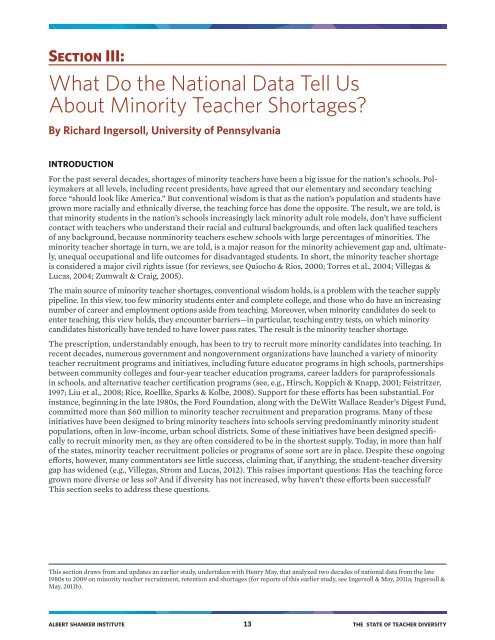TEACHER DIVERSITY
The State of Teacher Diversity_0
The State of Teacher Diversity_0
- No tags were found...
Create successful ePaper yourself
Turn your PDF publications into a flip-book with our unique Google optimized e-Paper software.
Section III:<br />
What Do the National Data Tell Us<br />
About Minority Teacher Shortages?<br />
By Richard Ingersoll, University of Pennsylvania<br />
INTRODUCTION<br />
For the past several decades, shortages of minority teachers have been a big issue for the nation’s schools. Policymakers<br />
at all levels, including recent presidents, have agreed that our elementary and secondary teaching<br />
force “should look like America.” But conventional wisdom is that as the nation’s population and students have<br />
grown more racially and ethnically diverse, the teaching force has done the opposite. The result, we are told, is<br />
that minority students in the nation’s schools increasingly lack minority adult role models, don’t have sufficient<br />
contact with teachers who understand their racial and cultural backgrounds, and often lack qualified teachers<br />
of any background, because nonminority teachers eschew schools with large percentages of minorities. The<br />
minority teacher shortage in turn, we are told, is a major reason for the minority achievement gap and, ultimately,<br />
unequal occupational and life outcomes for disadvantaged students. In short, the minority teacher shortage<br />
is considered a major civil rights issue (for reviews, see Quiocho & Rios, 2000; Torres et al., 2004; Villegas &<br />
Lucas, 2004; Zumwalt & Craig, 2005).<br />
The main source of minority teacher shortages, conventional wisdom holds, is a problem with the teacher supply<br />
pipeline. In this view, too few minority students enter and complete college, and those who do have an increasing<br />
number of career and employment options aside from teaching. Moreover, when minority candidates do seek to<br />
enter teaching, this view holds, they encounter barriers—in particular, teaching entry tests, on which minority<br />
candidates historically have tended to have lower pass rates. The result is the minority teacher shortage.<br />
The prescription, understandably enough, has been to try to recruit more minority candidates into teaching. In<br />
recent decades, numerous government and nongovernment organizations have launched a variety of minority<br />
teacher recruitment programs and initiatives, including future educator programs in high schools, partnerships<br />
between community colleges and four-year teacher education programs, career ladders for paraprofessionals<br />
in schools, and alternative teacher certification programs (see, e.g., Hirsch, Koppich & Knapp, 2001; Feistritzer,<br />
1997; Liu et al., 2008; Rice, Roellke, Sparks & Kolbe, 2008). Support for these efforts has been substantial. For<br />
instance, beginning in the late 1980s, the Ford Foundation, along with the DeWitt Wallace Reader’s Digest Fund,<br />
committed more than $60 million to minority teacher recruitment and preparation programs. Many of these<br />
initiatives have been designed to bring minority teachers into schools serving predominantly minority student<br />
populations, often in low-income, urban school districts. Some of these initiatives have been designed specifically<br />
to recruit minority men, as they are often considered to be in the shortest supply. Today, in more than half<br />
of the states, minority teacher recruitment policies or programs of some sort are in place. Despite these ongoing<br />
efforts, however, many commentators see little success, claiming that, if anything, the student-teacher diversity<br />
gap has widened (e.g., Villegas, Strom and Lucas, 2012). This raises important questions: Has the teaching force<br />
grown more diverse or less so? And if diversity has not increased, why haven’t these efforts been successful?<br />
This section seeks to address these questions.<br />
This section draws from and updates an earlier study, undertaken with Henry May, that analyzed two decades of national data from the late<br />
1980s to 2009 on minority teacher recruitment, retention and shortages (for reports of this earlier study, see Ingersoll & May, 2011a; Ingersoll &<br />
May, 2011b).<br />
ALBERT SHANKER INSTITUTE 13 THE STATE OF <strong>TEACHER</strong> <strong>DIVERSITY</strong>


